The Importance of Heart Rate Monitoring in Basketball Training
Understanding heart rate monitoring in basketball training is crucial for those seeking to enhance performance. By tracking heart rate, athletes gain insights into their training efficiency. This method enables players to see how their bodies respond to various training regimes, tailoring workouts to boost effectiveness and endurance.
Heart rate data plays a pivotal role in optimizing both performance and recovery. For basketball players, maintaining a balance between exertion and rest is essential. Monitoring one’s heart rate allows identification of recovery needs, ensuring that players are not overexerting themselves, thus minimizing injury risks. By observing heart rate patterns, coaches and athletes can establish personalized recovery strategies that benefit long-term performance improvement.
In the same genre : Ultimate time management guide: smart strategies for uk basketball players juggling training and personal life
For UK basketball players, leveraging heart rate monitoring offers tailored training insights, a significant advantage. Localized training adjustments based on heart data can lead to a more personalized training experience. This approach ensures that each player optimizes their energy usage, enhancing their on-court performance. The result is an efficient training regimen that not only increases physical capability but also sharpens strategic gameplay, ultimately benefiting the athlete’s overall career in basketball.
Top Recommended Heart Rate Monitors for Basketball Players
Choosing the right heart rate monitors is pivotal for athletes looking to maximize their basketball training. Various models cater to differing needs, making product reviews essential for informed decisions.
Overview of Recommended Monitors
When selecting a heart rate monitor, key features to look for include accuracy, comfort, and real-time data tracking. The top models often offer additional features like GPS tracking and Bluetooth connectivity, enhancing usability for athletes.
Features Comparison
Specific considerations when comparing models include battery life, ease of use, and waterproof design, which can significantly affect performance during intense training sessions. Popular monitors often boast user-friendly interfaces, with clear displays for quick data interpretation without disrupting the workout flow.
Price and Availability
Price ranges for heart rate monitors vary, typically from affordable options to premium models with advanced features. In the UK, these monitors are available from numerous retailers, both online and in-store, allowing easy access for consumers. Product reviews can guide buyers towards cost-effective choices that meet their needs without compromising on quality. Exploring the best options involves balancing features, costs, and personal training objectives, ensuring an investment in a monitor that aligns with performance goals.
Guidelines for Using Heart Rate Monitors Effectively
To maximise the benefits of heart rate monitors, understanding proper usage guidelines is essential. Ensuring the monitor is worn correctly during training sessions is crucial; it should be snug yet comfortable, positioned as per the manufacturer’s recommendations for accurate readings.
Interpreting heart rate data effectively is pivotal for meeting specific basketball training objectives. Once data is collected, focus on trends rather than isolated readings. This approach provides valuable insights into an athlete’s performance levels and recovery needs. For instance, noticing a consistently high heart rate might indicate overtraining or stress, suggesting necessary adjustments to prevent fatigue or injury.
Timing your monitoring techniques is another key factor. Collect data at different points during workouts and games to gain a comprehensive understanding of performance dynamics. Starting with measurement during warm-ups, through the peak of activity, and into cooldown phases, offers a full spectrum of how your heart responds to varying levels of exertion.
By adhering to these guidelines, athletes and coaches can leverage heart rate monitors effectively to enhance training efficiency, optimize results, and develop tailored strategies for improving on-court performance.
Leveraging Heart Rate Data to Enhance Training Regimens
Using heart rate data effectively is key to improving training integration and overall performance tracking. Heart rate monitoring can be seamlessly incorporated into existing training programs to create a more precise and tailored workout routine.
Strategies for Data Integration
To utilize training integration effectively, it’s vital to align heart rate targets with specific basketball drills or conditioning activities. This alignment ensures that each training session optimally targets the desired heart rate zones, maximizing efficiency. One effective technique is setting heart rate zones for various stages of practice or a game, helping athletes maintain proper exertion levels.
Case Studies of Successful Implementation
Numerous UK basketball players have turned to performance tracking through heart rate data, witnessing significant improvements. For instance, by adhering to strategies that prioritize recovery, players have reported enhanced endurance and fewer injuries. These examples underscore the practical benefits and underscore the importance of integrating such data into routine training.
Common Pitfalls to Avoid
When developing a training strategy, it’s crucial to consider potential pitfalls. Ignoring personalized heart rate trends can lead to inadequate stress management and potential overtraining. Moreover, failing to adapt the strategy to individual needs could result in strategy development misalignment, reducing overall effectiveness. Careful monitoring and customization of data use are essential to avoid these pitfalls.
Conclusion and Future Trends in Heart Rate Monitoring for Basketball
As technology continues to evolve, the future trends in heart rate monitoring for basketball promise significant advancements. Emerging technologies such as artificial intelligence and machine learning are set to revolutionise how heart rate data is interpreted and applied. With these technologies, players can expect more precise analysis of their performance, ultimately optimising basketball training.
Looking ahead, wearable devices might incorporate real-time feedback loops, enabling immediate adjustments based on heart rate readings. This innovation could transform how athletes adapt their exertion levels during practice or games, enhancing performance improvement efficiently. As these technology advances become more prevalent, the way basketball training is conducted may significantly evolve.
For athletes aspiring to stay ahead in their training regimen, keeping abreast of these innovations is essential. It is crucial to adopt the latest monitoring technology not only to enhance performance but also to mitigate injury risks. As heart rate monitoring becomes increasingly integrated into daily training, players should stay informed about these emerging trends to ensure continual training integration and success on the court. By embracing these advancements, the future of basketball training appears both promising and exciting.











